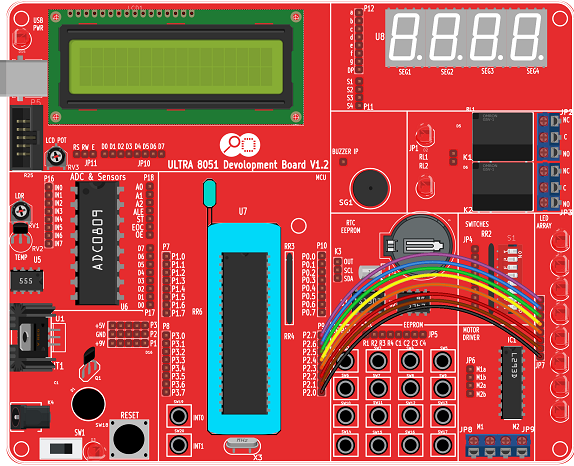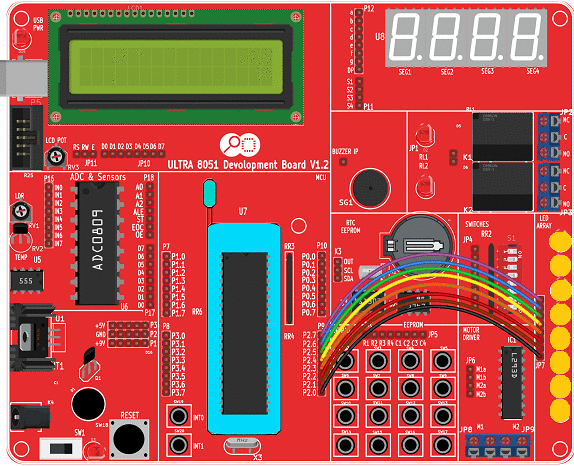Difference between revisions of "8051 Led Blinking"
| (8 intermediate revisions by the same user not shown) | |||
| Line 20: | Line 20: | ||
As shown in the above table many I/O pins have multiple functions. If a pin is used for other function then it may not be used as a gpio.<br> | As shown in the above table many I/O pins have multiple functions. If a pin is used for other function then it may not be used as a gpio.<br> | ||
| − | + | <br><br> | |
| − | + | ||
| − | + | ||
| − | + | ||
| − | + | ||
| − | + | ||
| − | + | ||
| − | + | ||
| − | + | ||
| − | + | ||
| − | + | ||
| − | + | ||
| − | + | ||
| − | + | ||
| − | + | ||
| − | + | ||
| − | + | ||
| − | + | ||
| − | + | ||
| − | + | ||
| − | + | ||
| − | + | ||
| − | + | ||
| − | + | ||
| − | + | ||
| − | + | ||
| − | + | ||
| − | + | ||
| − | + | ||
| − | + | ||
| − | + | ||
| − | + | ||
| − | + | ||
| − | + | ||
| − | + | ||
| − | + | ||
| − | + | ||
| − | + | ||
| − | + | ||
| − | + | ||
| − | + | ||
| − | + | ||
| − | + | ||
| − | + | ||
| − | + | ||
| − | + | ||
| − | + | ||
| − | + | ||
| − | + | ||
| − | + | ||
| − | + | ||
| − | + | ||
| − | + | ||
| − | + | ||
| − | + | ||
| − | + | ||
| − | + | ||
| − | + | ||
| − | + | ||
| − | + | ||
| − | + | ||
| − | + | ||
| − | + | ||
| − | + | ||
| − | + | ||
| − | + | ||
=Hardware Connections= | =Hardware Connections= | ||
| − | [[File: | + | [[File:8051LedBlinking.png]] |
<br><br> | <br><br> | ||
=Examples= | =Examples= | ||
===Example 1=== | ===Example 1=== | ||
| − | Program to demonstrate the LED blinking. | + | Program to demonstrate the LED blinking. LED's are connected to P2 as shown in the above image.<br> |
| − | + | LEDs are turned ON by sending a high pulse (All Ones).<br> | |
| − | LEDs are turned ON by sending a high pulse | + | After some time the LEDs are turned OFF by sending the low pulse (All Zeros). |
| − | After some time the LEDs are turned OFF by sending the low pulse | + | |
<html> | <html> | ||
| − | <script src="https://gist.github.com/SaheblalBagwan/ | + | <script src="https://gist.github.com/SaheblalBagwan/94e270ed5a083a2b1ca575958f1ca953.js"></script> |
</html> | </html> | ||
<br><br> | <br><br> | ||
===Example 2=== | ===Example 2=== | ||
| − | + | In this example, we will see how to access a single port pin to blink the LED. | |
| − | + | ||
<html> | <html> | ||
| − | <script src="https://gist.github.com/SaheblalBagwan/ | + | <script src="https://gist.github.com/SaheblalBagwan/eb446d21ebdc716914458c6c7fc41a60.js"></script> |
</html> | </html> | ||
<br><br> | <br><br> | ||
| − | |||
| − | |||
| − | |||
| − | |||
| − | |||
| − | + | =Demo= | |
| − | + | [[File:08051 LedBlinking.gif]] | |
| − | + | ||
| − | + | ||
| − | + | ||
| − | + | ||
= Downloads= | = Downloads= | ||
| − | Download the complete project folder from | + | Download the complete project folder from [https://github.com/ExploreEmbedded/8051_DevelopmentBoard this link]. |
| − | https:// | + | |
| − | |||
| − | Have | + | Have an opinion, suggestion , question or feedback about the article let it out here! |
{{DISQUS}} | {{DISQUS}} | ||
Latest revision as of 20:00, 3 September 2016
Light Emitting Diodes (LEDs) are simple and most commonly used electronic components to display the digital signal states. The LED emits light when current is passed through it. It could blow up if we pass more current, hence we put a current limiting resistor. Usually, 220, 470 and 1K ohm resistors are commonly used as limiting resistors. You can use any of these depending on the required brightness.
Lets, start blinking with LEDs and then generate the different patterns using the available LEDs.
Contents
8051 Ports
The basic and important feature of any controllers is the number of GPIO's available for connecting the peripherals. 8051 has 32-gpio's grouped into 4-Ports namely P0-P3 as shown in the below table.
| PORT | Number of Pins | Alternative Function |
| P0 | 8 (P0.0-P0.7) | AD0-AD7 (Address and Data bus) |
| P1 | 8 (P1.0-P1.7) | None |
| P2 | 8 (P2.0-P2.7) | A8-A15 (Higher Address Bus) |
| P3 | 8 (P3.0-P3.7) | UART, Interrupts, (T0/T1)Counters |
As shown in the above table many I/O pins have multiple functions. If a pin is used for other function then it may not be used as a gpio.
Hardware Connections
Examples
Example 1
Program to demonstrate the LED blinking. LED's are connected to P2 as shown in the above image.
LEDs are turned ON by sending a high pulse (All Ones).
After some time the LEDs are turned OFF by sending the low pulse (All Zeros).
Example 2
In this example, we will see how to access a single port pin to blink the LED.
Demo
Downloads
Download the complete project folder from this link.
Have an opinion, suggestion , question or feedback about the article let it out here!


